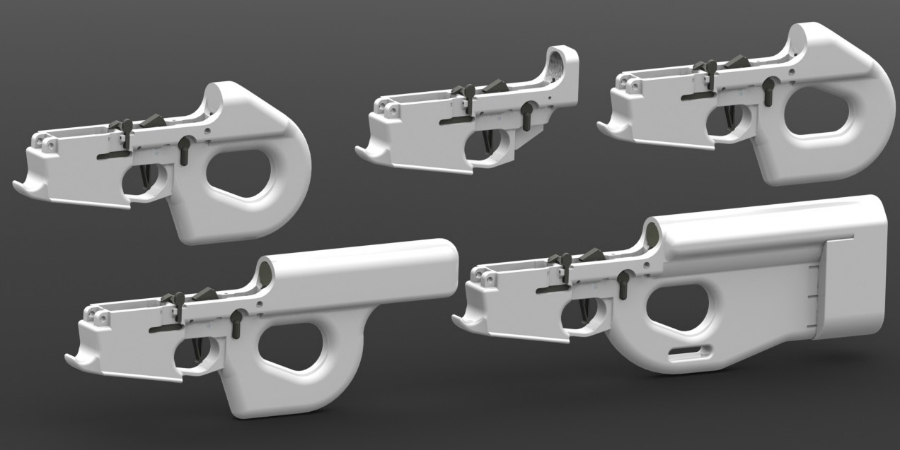Right-Wing Extremists’ New Weapon
Militants are manufacturing their own firearms to evade detection by law enforcement.

Published by The Lawfare Institute
in Cooperation With

Editor’s Note: When technology and terrorism intersect, the results are rarely good. As 3D printers and other do-it-yourself devices spread, terrorists are using them to make weapons. Eric Woods of Georgetown University explains how homemade weapons are giving terrorists new options and the resulting dangers they pose.
Daniel Byman
***
The Oct. 9 attack on a synagogue in Halle, Germany, highlights terrorists’ growing affinity for homemade firearms as a means for leaderless resistance, a decentralized strategy of guerrilla warfare popularized by Ku Klux Klan member Louis Beam. The guns used in the attack were improvised and craft produced, specifically a “slam-fire” shotgun and a “Luty” submachine pistol. The online extreme-right milieu on 8chan’s successor site, 8kun, was drawn to the particulars of the attack and its failures. In a thread detailing online resources for homemade weapons production, one user exclaimed: “Can we talk about Halle? I am angry at this ****** for building such nice homemade guns and then just wasting them.”
The most extensive evidence for extreme right terrorists’ growing interest in homemade firearms is on Telegram and can also be seen in private chats. A member of one active extremist chatroom recently shared an image of a Tec-9 he created by combining 3D-printed and metal parts. A short Google search leads directly to the CAD file used to manufacture it. On the largest open channels, which sometimes contain thousands of subscribers, expanded versions of the list of resources for homemade weapons production seen on 8kun are posted alongside calls for attacks on religious centers and minority communities. The posts demonstrate direct links between the extreme right communities online and their increasing discourse about the utility of homemade firearms for leaderless resistance.
But the interest is not just evidenced online. In October 2019, Kaleb Cole, a leader in the extremist Atomwaffen Division, had his firearms seized under Washington’s red flag laws. According to journalist Jake Hanrahan, who worked on the original investigation unmasking Atomwaffen, Cole was 3D-printing lower receivers, a firearm component necessary for assembling functional semiautomatic weapons that is regulated by the Bureau of Alcohol, Tobacco, Firearms and Explosives. In January, the FBI seized parts kits for milling AR-15s from the Delaware safehouse of The Base, an extreme right group; seven alleged members of the group were also arrested in advance of planned attacks against police and civilians at a pro-gun rally that occurred in Richmond, Virginia, on Jan. 20. Members of The Base believed that the use of the parts kits would make firearms used in attacks more difficult to trace and help them avoid police detection.
Everything Old Is New Again
Craft-produced firearms like the Luty gun used in the Halle attack are fabricated primarily from metal and in small numbers. Production requires only some technical skill and specialized tools. In contrast, improvised weapons like the crude slam-fire shotgun used in the attack require almost no technical skills. Both have been attractive to terrorists and guerrillas for decades now. The Jewish Underground, the Greek Cypriot nationalist group Eoka, the Mau Mau rebels in colonial Kenya, loyalist militias during the Troubles in Northern Ireland, and Palestinian groups have all used craft or improvised firearms. In 2016, a Palestinian attacker assassinated an Israeli law enforcement official using a craft-produced submachine gun, and in a separate incident that same year gunmen killed four people in an attack on a retail mall using the same kind of weapon.
Craft-produced firearms have multiple advantages for terrorists. They allow terrorists to circumvent traditional logistics concerns. There is no need to steal weapons from security forces if the weapons can be produced with minimal risk of detection. Additionally, the danger of producing firearms in a residence is lower than the risk of manufacturing explosives. While craft-produced and improvised guns made by amateurs are prone to accidents that can result in minor injuries, failures are not as lethal as mistakes made by bomb-makers.
Different Jurisdictions, Different Problem Sets
Given the risk of jamming and misfires, these varieties of homemade firearms are more useful for targeted violence than for mass killings like those committed by Anders Behring Breivik or Brenton Tarrant. But the threat posed by extreme right groups with access to unregistered firearms is real. After the assassination of British parliament member Jo Cox in 2016, British law enforcement seized guides on manufacturing homemade pistols. They continue to restrict sensitive materials and in September 2019 jailed an 18-year-old man for stockpiling manuals for creating automatic weapons. And on Feb. 14, German police seized a slam-fire shotgun during a raid on a terrorist cell planning attacks on mosques and assassinations of politicians.
A more salient issue for U.S. law enforcement is 3D-printed guns. Because 3D-printed guns made completely from plastics often cannot withstand the heat and pressure from firing live rounds, these weapons are more reliable when they incorporate original metal parts. Since most gun components in the United States are not regulated, criminals and would-be terrorists can avoid the attention of law enforcement by collecting unregulated parts piecemeal and combining them with 3D-printed versions of the controlled parts. The Tec-9 shared in the group chat is a clear example of this: The metal barrel was assembled with a 3D-printed receiver. This is what groups like The Base were doing to avoid detection. In Europe, where gun components are more tightly regulated, it is more difficult to assemble a complete weapon. Criminals have had to circumvent controls by taking on additional risks—such as trafficking gun barrels from the United States.
Homemade firearms—whether improvised, craft produced or 3D printed—have clear limitations. The most important factors are the patience and technical skill of the person crafting the firearm and the weapon’s reliability compared to a professionally manufactured gun. Additionally, much of the readily available information is of dubious reliability. Many guides online are unproven—a 21st-century equivalent of the Anarchist’s Cookbook, which is notorious for some of its more hare-brained concepts. However, cases like Anders Behring Breivik, who spent months accumulating and experimenting with bomb supplies in a rural workshop, demonstrate that a small subset of the extreme right is willing to experiment and dedicate copious amounts of time to improving the reliability of these weapons. The reduced dangers of self-harm and detection compared to bomb-making lowers the barriers to entry for these people. And the sheer level of interest and amount of evidence of homemade firearms and firearms parts used in attacks or seized by law enforcement in recent years makes it clear the issue is of growing concern.
This presents particular legal challenges to the United States, more so than other countries. The United States has an idiosyncratic approach to homemade production of firearms, rooted in its history as a frontier country where informal networks of artisan producers existed for decades before federal armories. This culture did not emerge in most other Western democracies that developed more centralized governments earlier. In most places the homemade manufacture of firearms is outright illegal. In the United States, though, serious reform of the legal regime would require both political will and technical knowledge on the part of legislators. As such, it is unlikely to happen. Would-be terrorists will continue trying to access more reliable supplies, but when those are unavailable, they are likely to turn to homemade weapons. They are already showing their determination and resourcefulness to work around the existing regime.





